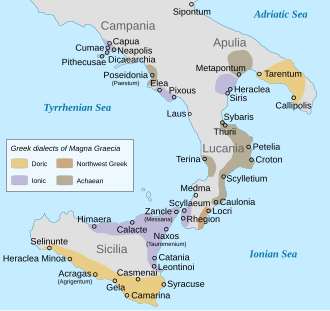
Back اليونانية الأيونية Arabic আইয়োনীয় উপভাষা Bengali/Bangla Grec jònic Catalan Iónština Czech Ionisches Griechisch German Ιωνική διάλεκτος Greek Iona (dialekto) Esperanto Griego jónico Spanish Joniera Basque Joonialainen murre Finnish
| Ionic Greek | ||||||
|---|---|---|---|---|---|---|
| Ἰωνικὴ διάλεκτος | ||||||
| Region | Circum-Aegean, Magna Graecia | |||||
| Era | c. 1000–300 BC | |||||
Indo-European
| ||||||
Early form | ||||||
| Greek alphabet | ||||||
| Language codes | ||||||
| ISO 639-3 | – | |||||
grc-ion | ||||||
| Glottolog | ioni1244 | |||||
Distribution of Greek dialects in Greece in the classical period.[1]
Distribution of Greek dialects in Magna Graecia (Southern Italy and Sicily) in the classical period.
| ||||||
Ionic or Ionian Greek (Ancient Greek: Ἰωνική, romanized: Iōnikḗ) was a subdialect of the Eastern or Attic–Ionic dialect group of Ancient Greek. The Ionic group traditionally comprises three dialectal varieties that were spoken in Euboea (West Ionic), the northern Cyclades (Central Ionic), and from c. 1000 BC onward in Asiatic Ionia (East Ionic), where Ionian colonists from Athens founded their cities.[2] Ionic was the base of several literary language forms of the Archaic and Classical periods, both in poetry and prose.[3] The works of Homer and Hesiod are among the most popular poetic works that were written in a literary form of the Ionic dialect, known as Epic or Homeric Greek. The oldest Greek prose, including that of Heraclitus, Herodotus, Democritus, and Hippocrates, was also written in Ionic. By the end of the 5th century BC, Ionic was supplanted by Attic, which had become the dominant dialect of the Greek world.[2]
- ^ Roger D. Woodard (2008), "Greek dialects", in: The Ancient Languages of Europe, ed. R. D. Woodard, Cambridge: Cambridge University Press, p. 51.
- ^ a b "Ionic dialect | Britannica". www.britannica.com. Retrieved 2023-11-29.
- ^ Barrio, María Luisa del (2013-09-24), "Ionic", Encyclopedia of Ancient Greek Language and Linguistics, Brill, retrieved 2023-11-29

